期末复习语法选择考点梳理及过关训练课件(共有PPT25张)
文档属性
| 名称 | 期末复习语法选择考点梳理及过关训练课件(共有PPT25张) |
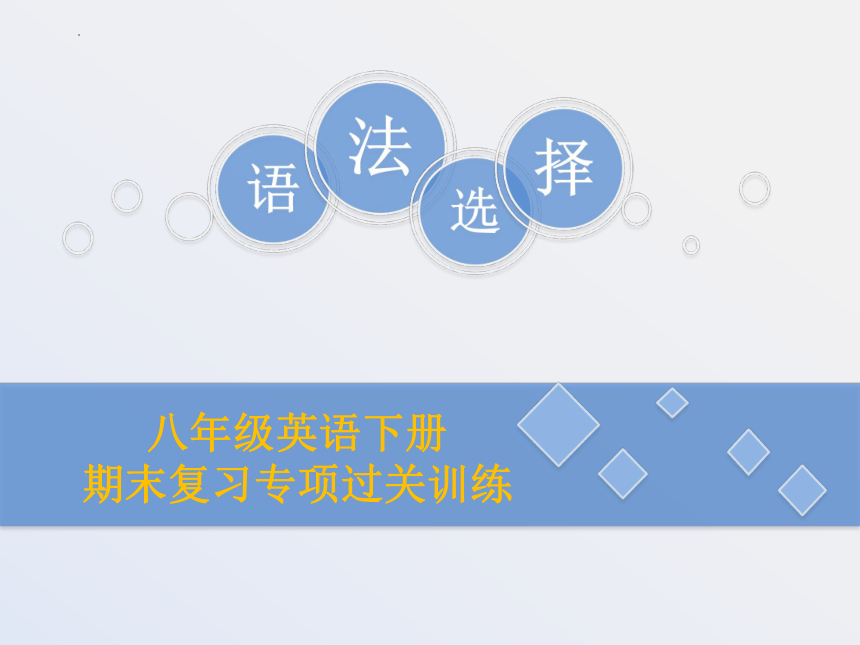
|
|
| 格式 | zip | ||
| 文件大小 | 1.4MB | ||
| 资源类型 | 教案 | ||
| 版本资源 | 牛津深圳版 | ||
| 科目 | 英语 | ||
| 更新时间 | 2022-03-27 10:33:06 | ||
图片预览

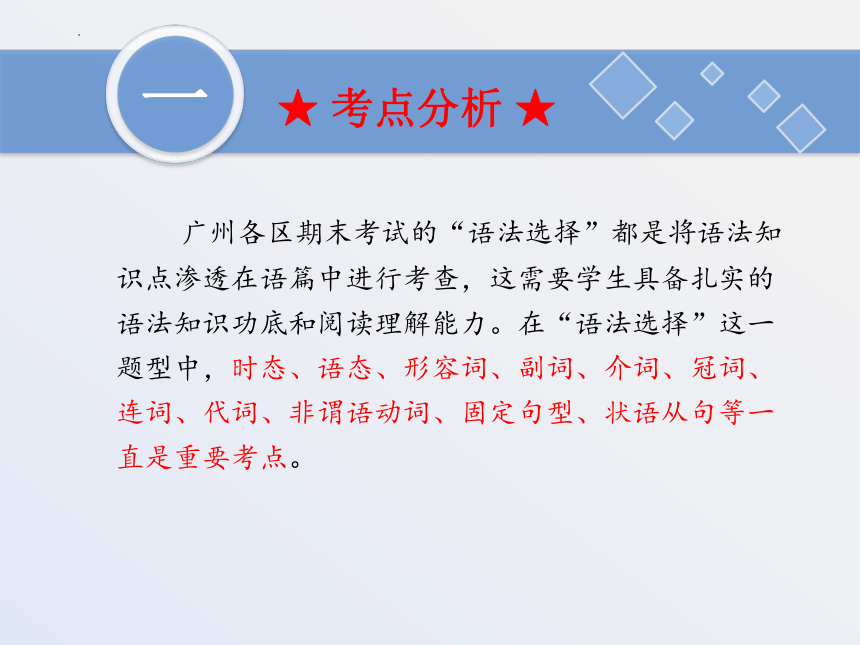
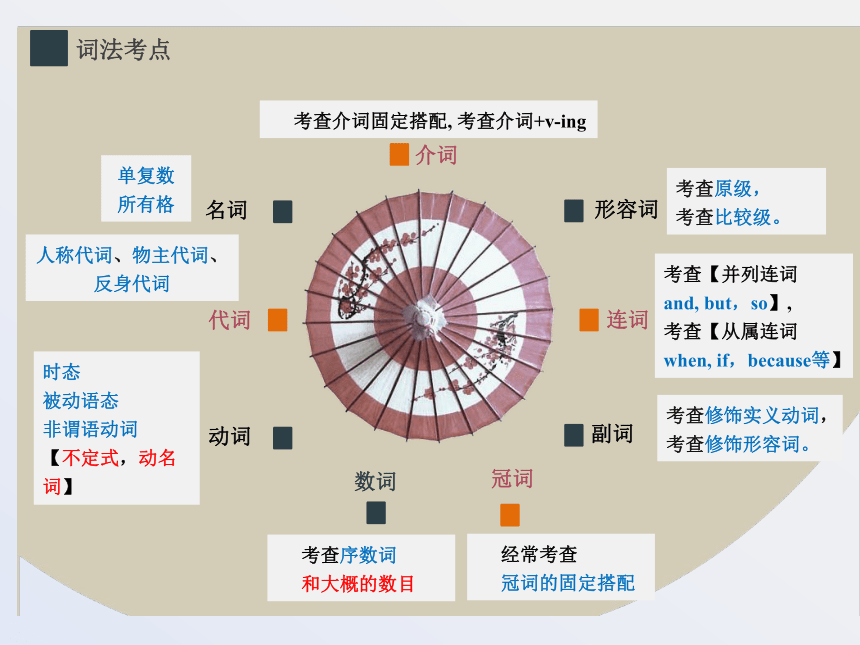
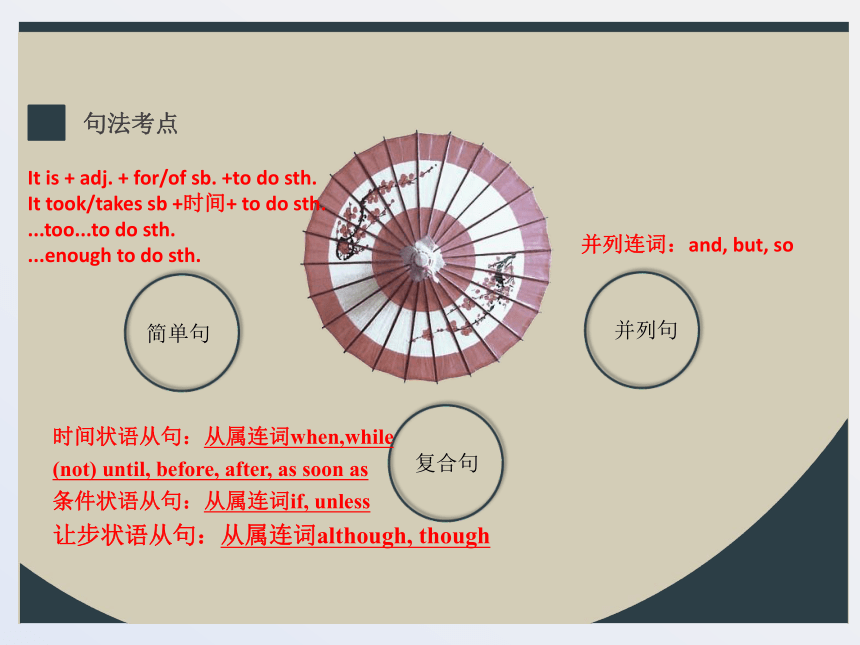
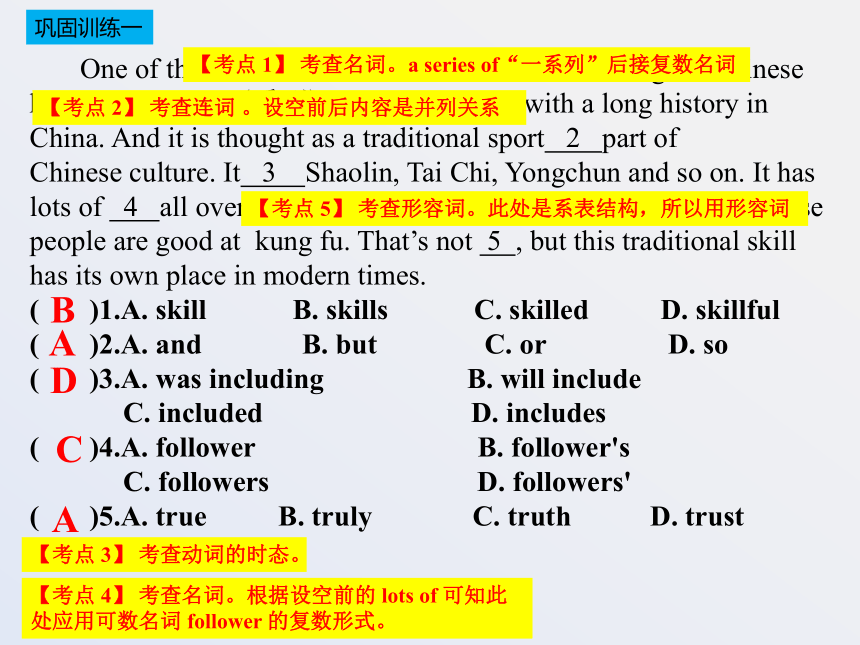
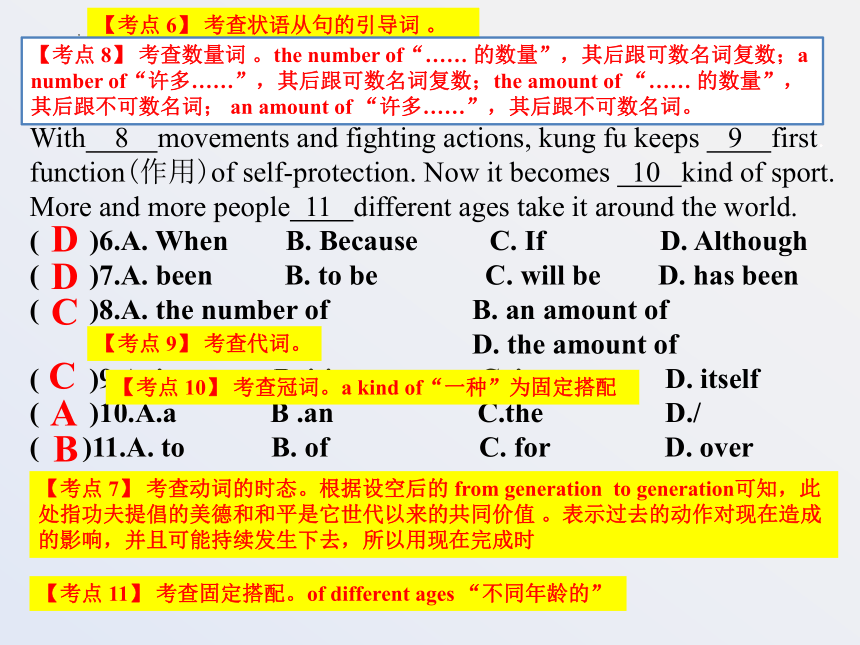
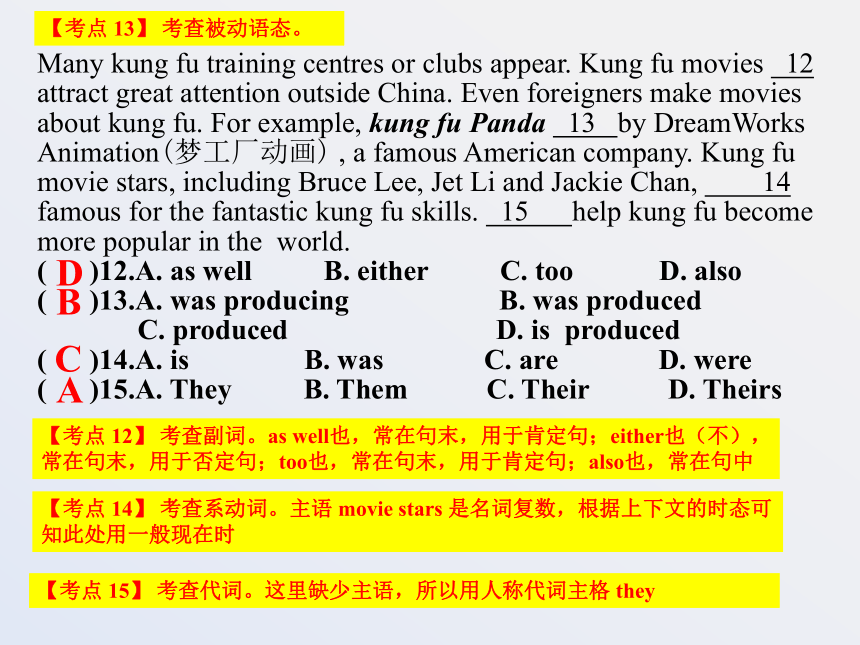
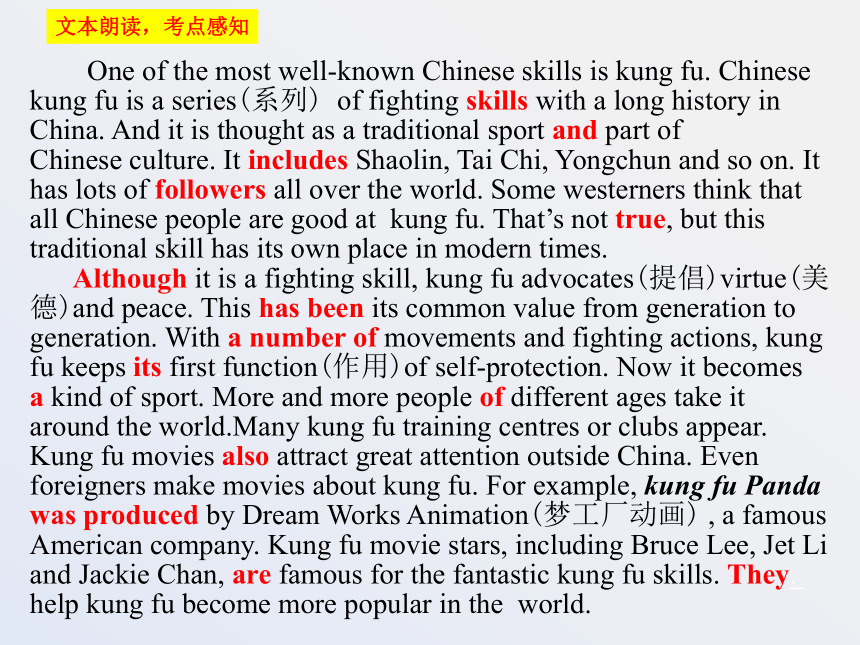
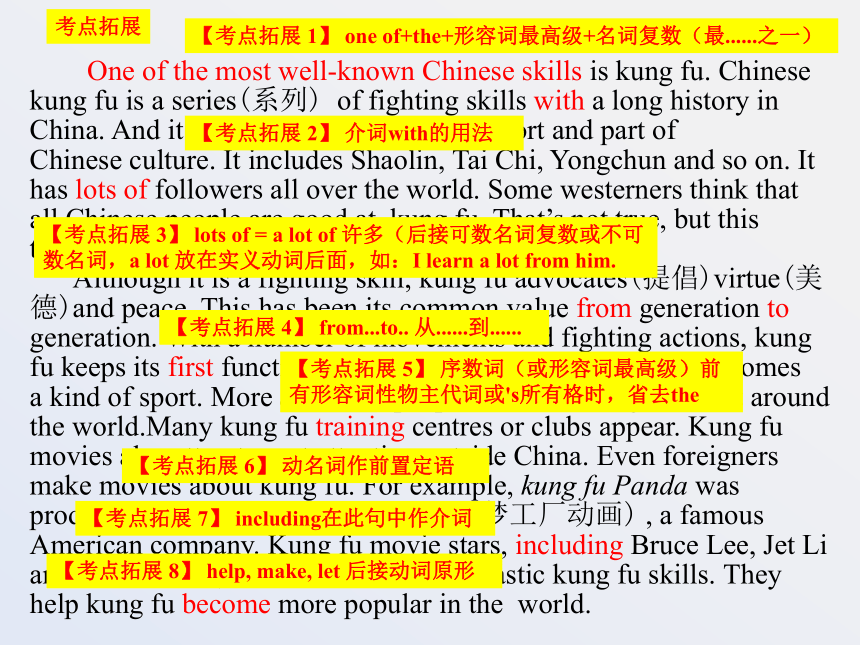
文档简介
(共25张PPT)
语
法
选
择
八年级英语下册
期末复习专项过关训练
广州各区期末考试的“语法选择”都是将语法知识点渗透在语篇中进行考查,这需要学生具备扎实的语法知识功底和阅读理解能力。在“语法选择”这一题型中,时态、语态、形容词、副词、介词、冠词、连词、代词、非谓语动词、固定句型、状语从句等一直是重要考点。
一
★ 考点分析 ★
名词
副词
动词
形容词
词法考点
代词
冠词
连词
介词
单复数
所有格
时态
被动语态
非谓语动词
【不定式,动名词】
考查原级,
考查比较级。
考查修饰实义动词,
考查修饰形容词。
考查序数词
和大概的数目
人称代词、物主代词、反身代词
数词
考查介词固定搭配, 考查介词+v-ing
考查【并列连词
and, but,so】,
考查【从属连词
when, if,because等】
经常考查
冠词的固定搭配
句法考点
简单句
并列句
复合句
时间状语从句:从属连词when,while
(not) until, before, after, as soon as
条件状语从句:从属连词if, unless
让步状语从句:从属连词although, though
并列连词:and, but, so
It is + adj. + for/of sb. +to do sth.
It took/takes sb +时间+ to do sth.
...too...to do sth.
...enough to do sth.
One of the most well-known Chinese skills is kung fu. Chinese kung fu is a series(系列) of fighting 1 with a long history in China. And it is thought as a traditional sport 2 part of
Chinese culture. It 3 Shaolin, Tai Chi, Yongchun and so on. It has lots of 4 all over the world. Some westerners think that all Chinese people are good at kung fu. That’s not 5 , but this traditional skill has its own place in modern times.
( )1.A. skill B. skills C. skilled D. skillful
( )2.A. and B. but C. or D. so
( )3.A. was including B. will include
C. included D. includes
( )4.A. follower B. follower's
C. followers D. followers'
( )5.A. true B. truly C. truth D. trust
B
【考点 1】 考查名词。a series of“一系列”后接复数名词
【考点 2】 考查连词 。设空前后内容是并列关系
A
D
C
A
【考点 3】 考查动词的时态。
【考点 4】 考查名词。根据设空前的 lots of 可知此处应用可数名词 follower 的复数形式。
【考点 5】 考查形容词。此处是系表结构,所以用形容词
巩固训练一
6 it is a fighting skill, kung fu advocates(提倡)virtue(美德)
and peace. This 7 its common value from generation to generation. With 8 movements and fighting actions, kung fu keeps 9 first. function(作用)of self-protection. Now it becomes 10 kind of sport. More and more people 11 different ages take it around the world.
( )6.A. When B. Because C. If D. Although
( )7.A. been B. to be C. will be D. has been
( )8.A. the number of B. an amount of
C. a number of D. the amount of
( )9.A. it B. it's C. its D. itself
( )10.A.a B .an C.the D./
( )11.A. to B. of C. for D. over
【考点 6】 考查状语从句的引导词 。
【考点 7】 考查动词的时态。根据设空后的 from generation to generation可知,此处指功夫提倡的美德和和平是它世代以来的共同价值 。表示过去的动作对现在造成的影响,并且可能持续发生下去,所以用现在完成时
【考点 8】 考查数量词 。the number of“…… 的数量”,其后跟可数名词复数;a number of“许多……”,其后跟可数名词复数;the amount of “…… 的数量”,其后跟不可数名词; an amount of “许多……”,其后跟不可数名词。
【考点 9】 考查代词。
【考点 10】 考查冠词。a kind of“一种”为固定搭配
【考点 11】 考查固定搭配。of different ages “不同年龄的”
D
D
C
C
A
B
Many kung fu training centres or clubs appear. Kung fu movies 12 attract great attention outside China. Even foreigners make movies about kung fu. For example, kung fu Panda 13 by DreamWorks Animation(梦工厂动画) , a famous American company. Kung fu movie stars, including Bruce Lee, Jet Li and Jackie Chan, 14 famous for the fantastic kung fu skills. 15 help kung fu become more popular in the world.
( )12.A. as well B. either C. too D. also
( )13.A. was producing B. was produced
C. produced D. is produced
( )14.A. is B. was C. are D. were
( )15.A. They B. Them C. Their D. Theirs
D
B
C
A
【考点 12】 考查副词。as well也,常在句末,用于肯定句;either也(不),常在句末,用于否定句;too也,常在句末,用于肯定句;also也,常在句中
【考点 13】 考查被动语态。
【考点 14】 考查系动词。主语 movie stars 是名词复数,根据上下文的时态可知此处用一般现在时
【考点 15】 考查代词。这里缺少主语,所以用人称代词主格 they
One of the most well-known Chinese skills is kung fu. Chinese kung fu is a series(系列) of fighting skills with a long history in China. And it is thought as a traditional sport and part of
Chinese culture. It includes Shaolin, Tai Chi, Yongchun and so on. It has lots of followers all over the world. Some westerners think that all Chinese people are good at kung fu. That’s not true, but this traditional skill has its own place in modern times.
Although it is a fighting skill, kung fu advocates(提倡)virtue(美德)and peace. This has been its common value from generation to generation. With a number of movements and fighting actions, kung fu keeps its first.function(作用)of self-protection. Now it becomes a kind of sport. More and more people of different ages take it around the world.Many kung fu training centres or clubs appear. Kung fu movies also attract great attention outside China. Even foreigners make movies about kung fu. For example, kung fu Panda was produced by Dream Works Animation(梦工厂动画) , a famous American company. Kung fu movie stars, including Bruce Lee, Jet Li and Jackie Chan, are famous for the fantastic kung fu skills. They. help kung fu become more popular in the world.
文本朗读,考点感知
One of the most well-known Chinese skills is kung fu. Chinese kung fu is a series(系列) of fighting skills with a long history in China. And it is thought as a traditional sport and part of
Chinese culture. It includes Shaolin, Tai Chi, Yongchun and so on. It has lots of followers all over the world. Some westerners think that all Chinese people are good at kung fu. That’s not true, but this traditional skill has its own place in modern times.
Although it is a fighting skill, kung fu advocates(提倡)virtue(美德)and peace. This has been its common value from generation to generation. With a number of movements and fighting actions, kung fu keeps its first function(作用)of self-protection. Now it becomes a kind of sport. More and more people of different ages take it around the world.Many kung fu training centres or clubs appear. Kung fu movies also attract great attention outside China. Even foreigners make movies about kung fu. For example, kung fu Panda was produced by Dream Works Animation(梦工厂动画) , a famous American company. Kung fu movie stars, including Bruce Lee, Jet Li and Jackie Chan, are famous for the fantastic kung fu skills. They help kung fu become more popular in the world.
考点拓展
【考点拓展 1】 one of+the+形容词最高级+名词复数(最......之一)
【考点拓展 2】 介词with的用法
【考点拓展 3】 lots of = a lot of 许多(后接可数名词复数或不可数名词,a lot 放在实义动词后面,如:I learn a lot from him.
【考点拓展 4】 from...to.. 从......到......
【考点拓展 5】 序数词(或形容词最高级)前有形容词性物主代词或's所有格时,省去the
【考点拓展 6】 动名词作前置定语
【考点拓展 7】 including在此句中作介词
【考点拓展 8】 help, make, let 后接动词原形
1. 缺主语
1.动名词做主语,谓语动词用单数
2.固定搭配(你觉得怎么样?)
What do you think
=How do you like
3. be busy (in) doing sth. 忙于做某事
5. ask sb. to do sth. 让某人做某事
6.everything 一切东西
巩固训练二
方式
为了
有
没有
8. 介词+V-ing /名词
9. be interested in doing sth.
对…感兴趣
10. both…and… 两者都(肯)
either…or… 要么…要么…(否)
neither…nor… 两者都不(否)
1找连词2判主从3断时态
12. a/an 表泛指;the表特指;/ 球棋三餐
13. It is adj.+for sb.+to do sth. 对某人来说做某事是怎么样的
14. 人+spend +钱/时间 (in)doing/on sth. 人花费时间/钱做某事
八年级单元相关知识点:四个“花费”的区别
1.He ________ most of his time ________ English.
A. spends. studying B. costs, studied C. takes, to study D. pays, studies
知识点过关训练
2.Roy works in London. It _________him about half an hour to get to work by bus every day.
A. costs B. spends C. takes
spend time (in) doing sth. 花费时间做某事
I spent two hours doing my homework yesterday.
spend time with sb. 和某人在一起度过
I will spend my summer holiday with my family.
spend (…) on花费
I spent 50 yuan on the book.
It takes sb. +时间+ to do sth. 做某事花费某人多少时间
It takes me 2 hours to do my homework every day.
语法选择考点梳理
1. 冠词
a/an+ 泛指(第一次出现)
the + 特指(第二次出现),最高级,序数词
注意:
(1)an+a,e,i,o
an + unusual/hour/honest/ 8 /18 / 80/ 11
a+European/university/usual/useful/UFO/uniform/one-year-old
(2) the+序数词(th)“第几”
a+序数词“再一,又一”
(3) the/his/her/one's+序数词+n,
eg: on my sister’s fifth birthday
(4) play the +乐器 play the violin
play +球类/棋类名词 play basketball/chess
2.名词
(1)常考不可数名词:
advice 建议 news 新闻 weather 天气 information 信息
money 钱 time 时间 paper 纸 tea 茶 water 水 milk 牛奶
(2)单复数同形:sheep绵羊,deer鹿,fish
(3)复合名词变复数:
有woman 或 man:
a woman teacher—— two women teachers
a man driver—— two men drivers
其他: an apple tree —— two apple trees
特殊情况: sports shoes 运动鞋
(4)某国人变复数:中日不变,英法变,其余S 加后面。
Chinese——Chinese Japanese——Japanese
American——Americans German—— Germans
(5) 名词所有格:
共同拥有,在最后一个人名后加:’s ,各自拥有: 每个人名后面都要加:’s
Jim and Kate’s mother Jim’s and Kate’s mothers
(6)双重所有格:
a friend of mine
a friend of Lily’s
a friend of Lily’s mother’s
3.代词
(1)one 泛指同类中的一个
it 特指上文提到过的同一个物体
that 用于比较级中,复数为:those
(2)形容词性物主代词+名词=名词性物主代词 your+ 名词=yours
my +名词=mine
her+名词=hers
their+名词=theirs
(3)不定代词:
either(两者之一),neither(两者都不)。
a little/little+不可数名词
a few /few +可数名词复数
有a 表肯定,没a 表否定
another+单数名词
other+复数名词
any other +单数名词
one…the other …一个…另一个…
some..others…一些…另一些...
(4)反身代词:
enjoy oneself 玩得开心
by oneself 靠自己,亲自
look after oneself 照顾自己
teach oneself…自学
4.数词
1) in one’s +基数词复数:
in his fifties 在他五十岁左右。
2) in the 1990s, in the 1990’s
在二十世纪九十年代
his/her/its +基数词 birthday
在某人...岁生日
4) half past six 六点半
a quarter to seven 六点四十五
5) a half 二分之一
a quarter 四分之一
one and a half 1个半...
6)当“hundred/million/billion/thousand “前有数词时,不要“s” 和”of”。没有数词时,都要加。
7)a +序数词 (又一,再一) the +序数词 (第几)
5.介词
1)时间介词
on +几月几日/星期几/星期几的早中晚/ 一个刮风的夜晚/节日等
at +时间点
in+年/月/季节/世纪/泛指早、中、晚
2)介词+动名词
in, at, by, to, about, without, before, after, through, towards...+ v-ing
6.形容词
(1)形容词的比较级句型:
the +比较级...,the+比较级...
(越...,就越...)
比较级+and +比较级 越来越
比较级+than
(2)最高级句型:
one of the +最高级+名词复数+谓语单数
(最...之一)
the+序数词+最高级 (第几最...)
(3)much /even/a lot/ a little/far +比较级
7. 主谓一致
(1) 就近原则:
either…or…要么...要么...
neither...nor…. 既不...也不...
not only…but also…不但...而且...
Not only parents but also he likes swimming.
(2) 就远原则:
谓语动词与这些词前面的主语保持一致:
with ,together with, as well as, but,except…
eg: He together with his parents likes swimming.
8. 感叹句
做题方法:
1)去主谓(若没有,这步可以省略)
2)看剩余部分的最后一个单词。
是名词用what, 是形容词或副词用how
3)若为可数名词单数,还要在what 后面加“a/an”
注意:time,surprise,rain,一日三餐前面如果加了形容词,
what 后面就要加“a/an”,
例如: What a good time it is!
What a great surprise it is!
What a heavy rain!
9.动词短语
(1)put:
put up 建立,粘贴
put on 穿上,增加,表演
put away 收拾,整理
put out 熄灭
put off 推迟
put down 放下,记下
(2)turn:
turn on 打开
turn off 关闭,
turn down 调低,拒绝
turn up 调高,出现
turn to 翻到,转向,求助于
(3)give :
give up 放弃,
give in 屈服,投降
give away 捐赠,赠送
give out 分发
give off 散发,
give back 归还
(4)take:
take care of 照顾 ,
take part in 参加
take away 拿走,带走
take it easy 别着急
take off 脱,起飞,
take place 发生
take up 占用
take pride in 以...为傲
谢·谢
See you next time!
语
法
选
择
八年级英语下册
期末复习专项过关训练
广州各区期末考试的“语法选择”都是将语法知识点渗透在语篇中进行考查,这需要学生具备扎实的语法知识功底和阅读理解能力。在“语法选择”这一题型中,时态、语态、形容词、副词、介词、冠词、连词、代词、非谓语动词、固定句型、状语从句等一直是重要考点。
一
★ 考点分析 ★
名词
副词
动词
形容词
词法考点
代词
冠词
连词
介词
单复数
所有格
时态
被动语态
非谓语动词
【不定式,动名词】
考查原级,
考查比较级。
考查修饰实义动词,
考查修饰形容词。
考查序数词
和大概的数目
人称代词、物主代词、反身代词
数词
考查介词固定搭配, 考查介词+v-ing
考查【并列连词
and, but,so】,
考查【从属连词
when, if,because等】
经常考查
冠词的固定搭配
句法考点
简单句
并列句
复合句
时间状语从句:从属连词when,while
(not) until, before, after, as soon as
条件状语从句:从属连词if, unless
让步状语从句:从属连词although, though
并列连词:and, but, so
It is + adj. + for/of sb. +to do sth.
It took/takes sb +时间+ to do sth.
...too...to do sth.
...enough to do sth.
One of the most well-known Chinese skills is kung fu. Chinese kung fu is a series(系列) of fighting 1 with a long history in China. And it is thought as a traditional sport 2 part of
Chinese culture. It 3 Shaolin, Tai Chi, Yongchun and so on. It has lots of 4 all over the world. Some westerners think that all Chinese people are good at kung fu. That’s not 5 , but this traditional skill has its own place in modern times.
( )1.A. skill B. skills C. skilled D. skillful
( )2.A. and B. but C. or D. so
( )3.A. was including B. will include
C. included D. includes
( )4.A. follower B. follower's
C. followers D. followers'
( )5.A. true B. truly C. truth D. trust
B
【考点 1】 考查名词。a series of“一系列”后接复数名词
【考点 2】 考查连词 。设空前后内容是并列关系
A
D
C
A
【考点 3】 考查动词的时态。
【考点 4】 考查名词。根据设空前的 lots of 可知此处应用可数名词 follower 的复数形式。
【考点 5】 考查形容词。此处是系表结构,所以用形容词
巩固训练一
6 it is a fighting skill, kung fu advocates(提倡)virtue(美德)
and peace. This 7 its common value from generation to generation. With 8 movements and fighting actions, kung fu keeps 9 first. function(作用)of self-protection. Now it becomes 10 kind of sport. More and more people 11 different ages take it around the world.
( )6.A. When B. Because C. If D. Although
( )7.A. been B. to be C. will be D. has been
( )8.A. the number of B. an amount of
C. a number of D. the amount of
( )9.A. it B. it's C. its D. itself
( )10.A.a B .an C.the D./
( )11.A. to B. of C. for D. over
【考点 6】 考查状语从句的引导词 。
【考点 7】 考查动词的时态。根据设空后的 from generation to generation可知,此处指功夫提倡的美德和和平是它世代以来的共同价值 。表示过去的动作对现在造成的影响,并且可能持续发生下去,所以用现在完成时
【考点 8】 考查数量词 。the number of“…… 的数量”,其后跟可数名词复数;a number of“许多……”,其后跟可数名词复数;the amount of “…… 的数量”,其后跟不可数名词; an amount of “许多……”,其后跟不可数名词。
【考点 9】 考查代词。
【考点 10】 考查冠词。a kind of“一种”为固定搭配
【考点 11】 考查固定搭配。of different ages “不同年龄的”
D
D
C
C
A
B
Many kung fu training centres or clubs appear. Kung fu movies 12 attract great attention outside China. Even foreigners make movies about kung fu. For example, kung fu Panda 13 by DreamWorks Animation(梦工厂动画) , a famous American company. Kung fu movie stars, including Bruce Lee, Jet Li and Jackie Chan, 14 famous for the fantastic kung fu skills. 15 help kung fu become more popular in the world.
( )12.A. as well B. either C. too D. also
( )13.A. was producing B. was produced
C. produced D. is produced
( )14.A. is B. was C. are D. were
( )15.A. They B. Them C. Their D. Theirs
D
B
C
A
【考点 12】 考查副词。as well也,常在句末,用于肯定句;either也(不),常在句末,用于否定句;too也,常在句末,用于肯定句;also也,常在句中
【考点 13】 考查被动语态。
【考点 14】 考查系动词。主语 movie stars 是名词复数,根据上下文的时态可知此处用一般现在时
【考点 15】 考查代词。这里缺少主语,所以用人称代词主格 they
One of the most well-known Chinese skills is kung fu. Chinese kung fu is a series(系列) of fighting skills with a long history in China. And it is thought as a traditional sport and part of
Chinese culture. It includes Shaolin, Tai Chi, Yongchun and so on. It has lots of followers all over the world. Some westerners think that all Chinese people are good at kung fu. That’s not true, but this traditional skill has its own place in modern times.
Although it is a fighting skill, kung fu advocates(提倡)virtue(美德)and peace. This has been its common value from generation to generation. With a number of movements and fighting actions, kung fu keeps its first.function(作用)of self-protection. Now it becomes a kind of sport. More and more people of different ages take it around the world.Many kung fu training centres or clubs appear. Kung fu movies also attract great attention outside China. Even foreigners make movies about kung fu. For example, kung fu Panda was produced by Dream Works Animation(梦工厂动画) , a famous American company. Kung fu movie stars, including Bruce Lee, Jet Li and Jackie Chan, are famous for the fantastic kung fu skills. They. help kung fu become more popular in the world.
文本朗读,考点感知
One of the most well-known Chinese skills is kung fu. Chinese kung fu is a series(系列) of fighting skills with a long history in China. And it is thought as a traditional sport and part of
Chinese culture. It includes Shaolin, Tai Chi, Yongchun and so on. It has lots of followers all over the world. Some westerners think that all Chinese people are good at kung fu. That’s not true, but this traditional skill has its own place in modern times.
Although it is a fighting skill, kung fu advocates(提倡)virtue(美德)and peace. This has been its common value from generation to generation. With a number of movements and fighting actions, kung fu keeps its first function(作用)of self-protection. Now it becomes a kind of sport. More and more people of different ages take it around the world.Many kung fu training centres or clubs appear. Kung fu movies also attract great attention outside China. Even foreigners make movies about kung fu. For example, kung fu Panda was produced by Dream Works Animation(梦工厂动画) , a famous American company. Kung fu movie stars, including Bruce Lee, Jet Li and Jackie Chan, are famous for the fantastic kung fu skills. They help kung fu become more popular in the world.
考点拓展
【考点拓展 1】 one of+the+形容词最高级+名词复数(最......之一)
【考点拓展 2】 介词with的用法
【考点拓展 3】 lots of = a lot of 许多(后接可数名词复数或不可数名词,a lot 放在实义动词后面,如:I learn a lot from him.
【考点拓展 4】 from...to.. 从......到......
【考点拓展 5】 序数词(或形容词最高级)前有形容词性物主代词或's所有格时,省去the
【考点拓展 6】 动名词作前置定语
【考点拓展 7】 including在此句中作介词
【考点拓展 8】 help, make, let 后接动词原形
1. 缺主语
1.动名词做主语,谓语动词用单数
2.固定搭配(你觉得怎么样?)
What do you think
=How do you like
3. be busy (in) doing sth. 忙于做某事
5. ask sb. to do sth. 让某人做某事
6.everything 一切东西
巩固训练二
方式
为了
有
没有
8. 介词+V-ing /名词
9. be interested in doing sth.
对…感兴趣
10. both…and… 两者都(肯)
either…or… 要么…要么…(否)
neither…nor… 两者都不(否)
1找连词2判主从3断时态
12. a/an 表泛指;the表特指;/ 球棋三餐
13. It is adj.+for sb.+to do sth. 对某人来说做某事是怎么样的
14. 人+spend +钱/时间 (in)doing/on sth. 人花费时间/钱做某事
八年级单元相关知识点:四个“花费”的区别
1.He ________ most of his time ________ English.
A. spends. studying B. costs, studied C. takes, to study D. pays, studies
知识点过关训练
2.Roy works in London. It _________him about half an hour to get to work by bus every day.
A. costs B. spends C. takes
spend time (in) doing sth. 花费时间做某事
I spent two hours doing my homework yesterday.
spend time with sb. 和某人在一起度过
I will spend my summer holiday with my family.
spend (…) on花费
I spent 50 yuan on the book.
It takes sb. +时间+ to do sth. 做某事花费某人多少时间
It takes me 2 hours to do my homework every day.
语法选择考点梳理
1. 冠词
a/an+ 泛指(第一次出现)
the + 特指(第二次出现),最高级,序数词
注意:
(1)an+a,e,i,o
an + unusual/hour/honest/ 8 /18 / 80/ 11
a+European/university/usual/useful/UFO/uniform/one-year-old
(2) the+序数词(th)“第几”
a+序数词“再一,又一”
(3) the/his/her/one's+序数词+n,
eg: on my sister’s fifth birthday
(4) play the +乐器 play the violin
play +球类/棋类名词 play basketball/chess
2.名词
(1)常考不可数名词:
advice 建议 news 新闻 weather 天气 information 信息
money 钱 time 时间 paper 纸 tea 茶 water 水 milk 牛奶
(2)单复数同形:sheep绵羊,deer鹿,fish
(3)复合名词变复数:
有woman 或 man:
a woman teacher—— two women teachers
a man driver—— two men drivers
其他: an apple tree —— two apple trees
特殊情况: sports shoes 运动鞋
(4)某国人变复数:中日不变,英法变,其余S 加后面。
Chinese——Chinese Japanese——Japanese
American——Americans German—— Germans
(5) 名词所有格:
共同拥有,在最后一个人名后加:’s ,各自拥有: 每个人名后面都要加:’s
Jim and Kate’s mother Jim’s and Kate’s mothers
(6)双重所有格:
a friend of mine
a friend of Lily’s
a friend of Lily’s mother’s
3.代词
(1)one 泛指同类中的一个
it 特指上文提到过的同一个物体
that 用于比较级中,复数为:those
(2)形容词性物主代词+名词=名词性物主代词 your+ 名词=yours
my +名词=mine
her+名词=hers
their+名词=theirs
(3)不定代词:
either(两者之一),neither(两者都不)。
a little/little+不可数名词
a few /few +可数名词复数
有a 表肯定,没a 表否定
another+单数名词
other+复数名词
any other +单数名词
one…the other …一个…另一个…
some..others…一些…另一些...
(4)反身代词:
enjoy oneself 玩得开心
by oneself 靠自己,亲自
look after oneself 照顾自己
teach oneself…自学
4.数词
1) in one’s +基数词复数:
in his fifties 在他五十岁左右。
2) in the 1990s, in the 1990’s
在二十世纪九十年代
his/her/its +基数词 birthday
在某人...岁生日
4) half past six 六点半
a quarter to seven 六点四十五
5) a half 二分之一
a quarter 四分之一
one and a half 1个半...
6)当“hundred/million/billion/thousand “前有数词时,不要“s” 和”of”。没有数词时,都要加。
7)a +序数词 (又一,再一) the +序数词 (第几)
5.介词
1)时间介词
on +几月几日/星期几/星期几的早中晚/ 一个刮风的夜晚/节日等
at +时间点
in+年/月/季节/世纪/泛指早、中、晚
2)介词+动名词
in, at, by, to, about, without, before, after, through, towards...+ v-ing
6.形容词
(1)形容词的比较级句型:
the +比较级...,the+比较级...
(越...,就越...)
比较级+and +比较级 越来越
比较级+than
(2)最高级句型:
one of the +最高级+名词复数+谓语单数
(最...之一)
the+序数词+最高级 (第几最...)
(3)much /even/a lot/ a little/far +比较级
7. 主谓一致
(1) 就近原则:
either…or…要么...要么...
neither...nor…. 既不...也不...
not only…but also…不但...而且...
Not only parents but also he likes swimming.
(2) 就远原则:
谓语动词与这些词前面的主语保持一致:
with ,together with, as well as, but,except…
eg: He together with his parents likes swimming.
8. 感叹句
做题方法:
1)去主谓(若没有,这步可以省略)
2)看剩余部分的最后一个单词。
是名词用what, 是形容词或副词用how
3)若为可数名词单数,还要在what 后面加“a/an”
注意:time,surprise,rain,一日三餐前面如果加了形容词,
what 后面就要加“a/an”,
例如: What a good time it is!
What a great surprise it is!
What a heavy rain!
9.动词短语
(1)put:
put up 建立,粘贴
put on 穿上,增加,表演
put away 收拾,整理
put out 熄灭
put off 推迟
put down 放下,记下
(2)turn:
turn on 打开
turn off 关闭,
turn down 调低,拒绝
turn up 调高,出现
turn to 翻到,转向,求助于
(3)give :
give up 放弃,
give in 屈服,投降
give away 捐赠,赠送
give out 分发
give off 散发,
give back 归还
(4)take:
take care of 照顾 ,
take part in 参加
take away 拿走,带走
take it easy 别着急
take off 脱,起飞,
take place 发生
take up 占用
take pride in 以...为傲
谢·谢
See you next time!
同课章节目录
